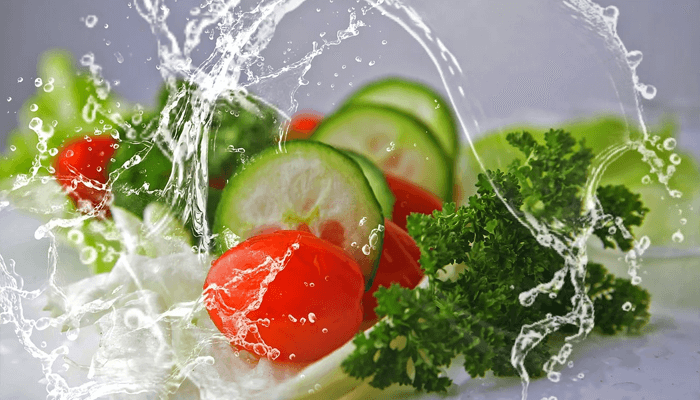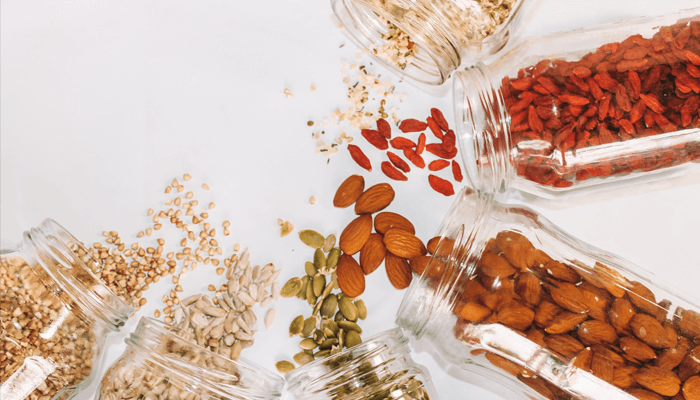7 Benefits of Eating Salads Regularly
Table of Contents
Salad has mostly been a side-dish in the Indian diet except for people eating cucumber, carrot or radish with black salt in the afternoon. Onions, cabbage, lettuce, carrots, tomatoes, etc. are usually sliced, sprinkled with a pinch of salt and lemon and served along with meals. Lately, however, salads have been accepted as main meals and it’s time our diets were upgraded.
Salads can be prepared in many creative ways for them to be tasty, appealing, crunchy, nutritious, and filling. They are particularly easy to make and easily available at most restaurants and cafes. Irrespective of the weather, salads can be consumed throughout the year and reap their health benefits. Check out FITFEAST here with which you can get in touch with certified nutritionists at your convenience for personalized diets.
Are salads good for weight loss?
There are many suggestive replies to whether eating salads daily can become an effective technique to lose weight. Many health experts suggest that salads work best as sides to your main course as they effectively help in proper digestion due to the presence of fiber. Whereas, if you're rigorously looking for a routine where you want to shed extra kilos off your body quickly, then eating salads as your main meal can help you control your appetite and kill your hunger pangs for other junk foods. But the question remains, whether or not we must follow a salad diet daily.
Every human body responds differently. For some eating salads daily may not have negative effects but for some cutting down the appetite for salad specifically can hurt the body. Salads are loaded with essential nutrients including fiber, healthy fats, and water. It's important to mention keeping salads alongside your regular meals can typically benefit you better. Even if you choose to consume salad as your main meal then designing a perfect combination of everything healthy and consuming it all day can work wonders.
Salads are considered to be really good for weight loss as a typical weight loss process may require burning more calories than you eat. Typical salad element includes fruits, vegetables, and nuts in small amounts, high in water content, fiber, and good fats that satisfy your hunger without packing on the calories.
If your goal is to lose weight by eating salad every day, pay attention to the ingredients you choose and the portions you eat. Increase your intake of fruits and vegetables and decrease your intake of proteins and fats. Additionally, pay attention to the salad dressing you use. Your best option is to use small amounts of natural dressings that are based on oil.
Benefits of Salad Diet
Let us now explore some of the key benefits of eating salad, how is salad good for weight loss, and what other benefits we derive from incorporating salad into our meal plan.

Once you acquire the taste, it’s hard to stay away from their crunchy texture, vibrant colors, and mesmerizing smells. Consuming freshly cut raw vegetables every day is beneficial for your health. The nutrients in the veggies improve your overall health and prevent diseases. They help you maintain a healthy weight and an energy that is reminiscent of younger years. Why not eat vegetables if they give you extra energy and liveliness? Plus, a salad is perhaps one of the easiest foods to prepare.

Leafy greens and raw vegetables are packed with fiber, which is the most important carbohydrate. It helps in regulating cholesterol levels; reduces LDL or bad cholesterol. Fiber is essential in controlling blood sugar as well. Consuming fiber-rich foods helps you lose weight and maintain it in the long run. Fiber promotes healthy bowel movements and prevents bowel disease. Doctors suggest taking a fiber-rich diet because it prevents and reduces the recurrence of several types of cancers like breast, mouth, colorectal, throat, esophageal and others.

Fresh vegetables and fruits are essential for our well being. But that’s nothing you don’t know. Why, then, do we stay away from vegetables and fruits? According to public health experts, you can lower blood pressure, reduce the risk of stroke, heart disease, eye problems, and digestive distress simply by including fruits and vegetables in your diet. They also keep your appetite in check. While the different colors of fruits and vegetables are very natural to us, you might not know that all of them have different nutrients and you are advised to consume a variety of fruits and veggies in as many different colors as possible.
Moreover, you can add both fruits and vegetables and prepare a delicious salad within a few minutes. They are packed with nutrients and increase the level of antioxidants in your body. Spinach, kale, lettuce, beet greens, watercress, etc. are some of the best green vegetables.

We have already established that fiber has several health benefits. Eating a salad as an entré or a main dish will fill you up faster thereby, making you consume less. Therefore, your salad should be full of as many raw vegetables as possible. These veggies and most fruits are low in calories and high in nutrients. That’s why eating salads every day can help you stay slim or maintain your weight. Replace fatty foods with salads. Eating a salad every day will manifest a difference within a few weeks.

Salads can be topped with several things; sprinkle a couple of tablespoons of raw or roasted seeds. Add sesame, pumpkin, sunflower, chia, ground flax, and other seeds to get your daily intake of good fats. You can also add small quantities of healthy oils like olive oil as well. Add a few slices of an avocado to make your salad even better. These additions help the body in absorbing the lutein, phytochemicals, and protective compounds. Plus, they make the salad more filling.

You must have read or heard that to build and repair muscles, you need to consume protein. That much is true. However, if you skimp on other essentials like veggies and fruits, you might not be getting the best of your exertions. Certain vegetables like spinach are not only good for the bones but for your energy levels and muscles as well. The nutrients present in vegetables improve the performance of the mitochondria – the powerhouse of the cell. This helps you when you workout or perform and exercise. Consume beets, spinach, mushrooms, sweet potato, peppers, etc. The vegetables that cannot be eaten raw can be boiled of course.

Several vegetables that you add in your salad contain Vitamin A and C in the form of carotenoids. Leafy greens like spinach also contain Vitamin C in addition to high amounts of Vitamin A. Carrots are rich in Vitamin A as well. Broccoli, tomatoes, and red peppers have a more balanced mix of these antioxidants. Red peppers, especially, are packed with these antioxidants. Veggies like red lettuce, romaine, and spinach are good for your eyes; they help them adjust from bright to dark in addition to filtering out high-intensity light. This protects them from the damage caused by free radicals.
Types of Healthy Salads
Now that we know there are many benefits of adding salads to your daily diet, it's time to explore a few types of healthy salads that you can try to satiate your health and hunger.
A delectable chicken breast and peanut salad, quinoa chickpea salad, chopped tofu & peanut dressing salad, or a toothsome Greek salmon salad, a perfect blend of high-protein ingredients can make you a delightful luncheon.
Slow-cooker chicken taco salad, shrimp salads, tuna and white bean salad, cauliflower potato salad, Asian style chicken slaw, cucumber salad, marinated tomato salad, and whatever constitutes low-calorie ingredients can work well with your weight loss routine.
Try making chipotle lime avocado salad, lemon rice salad, pear salad with parmesan dressing, or cherry tomatoes salad. With gluten-free ingredients, one can rejoice in the perfect blend of taste and health. Even a simple fresh fruit bowl can satiate your soul and speed up your weight loss journey.
Servings of each salad constitute 15 grams of carbohydrates. These include Basil and Mozzarella salad, broccoli salad with Bacon, Cucumber Feta salad, Guacamole chopped salad, or spiced grilled Chicken with Cauliflower.
Combine your salad ingredients with less amount of salt, and make a good blend of carrot cucumber salad, chickpeas salad, shrimp cobb salad, no-cook black bean salad, creamy pesto chicken salad with greens, and more.
Which salad is the healthiest?
There are many healthy options if you're choosing to follow a healthy salad diet routine including, high-protein salad, low-calorie salad, gluten free salad, low-carb salad, low-salt salad etc.
What are the benefits of eating a salad?
There are many benefits of eating a salad as it has anti-aging properties, Fiber-rich ingredients, is packed with nutrients, helps in weight management, source of healthy fats, is rich in antioxidants, improves muscle performance, and much more.
Is it OK if I eat salad everyday?
It's OK to eat salad everyday if your digestive system allows it. You can perfectly combine salads with your regular meals or eat a medium-sized bowl of salad during the lunch hour. Eating salad can help you control your appetite and reduce your hunger pangs.
What does Vegetable Salad Contain?
A vegetable salad typically contains a variety of fresh vegetables, such as lettuce, tomatoes, cucumbers, carrots, and bell peppers, often with added proteins or dressings.
Why should we Eat Salads and Fruits be a Regular items in Lunch or Dinner?
Salads and fruits provide essential vitamins, minerals, fibre, and antioxidants, promoting overall health, digestion, and weight management.
How to Burn Fat in Thighs?
To burn thigh fat, combine strength training exercises like squats and lunges with cardiovascular activities and maintain a balanced diet.
How to Decrease Thigh Fat?
Engage in regular aerobic exercises, incorporate resistance training targeting the thighs, and follow a calorie-controlled, nutrient-dense diet.
How to Decrease Thighs?
To reduce overall body fat and slim down thighs, focus on a mix of cardio exercises, strength training, and a healthy diet.
How to Loose Thigh Fat?
Combine leg-focused strength training with cardio workouts and a balanced diet to effectively lose thigh fat.
How to Loose Thighs Fat?
To lose fat in the thighs, incorporate exercises like squats, lunges, and running, paired with a healthy diet.
How to Lose Fat in Thighs?
To lose thigh fat, perform regular cardio and strength training exercises, focusing on the lower body, and maintain a healthy diet.
How to Lose Theigh Fat?
To lose thigh fat, engage in consistent physical activity, including cardio and leg-strengthening exercises, and follow a balanced diet.
How to Lose Thigh Fat?
Combine aerobic exercises, resistance training targeting the thighs, and a nutritious diet to effectively reduce thigh fat.
How to Lose Thigh Fats?
Regular exercise, particularly leg workouts and cardio, and a healthy diet can help you lose thigh fat.
How to Lose Thigh Weight?
To reduce fat and weight in the thighs, incorporate cardiovascular exercises, strength training, and proper nutrition.


